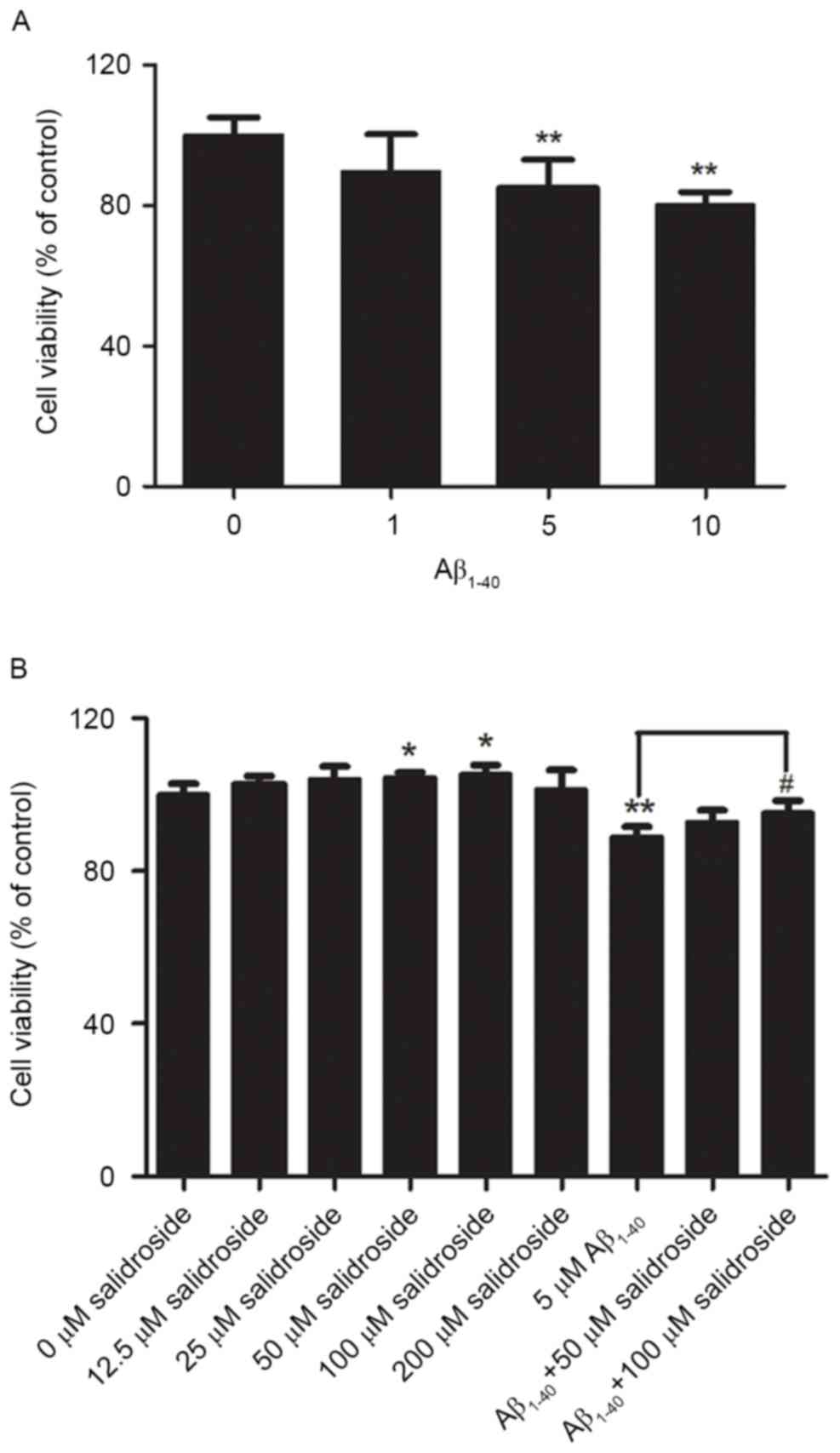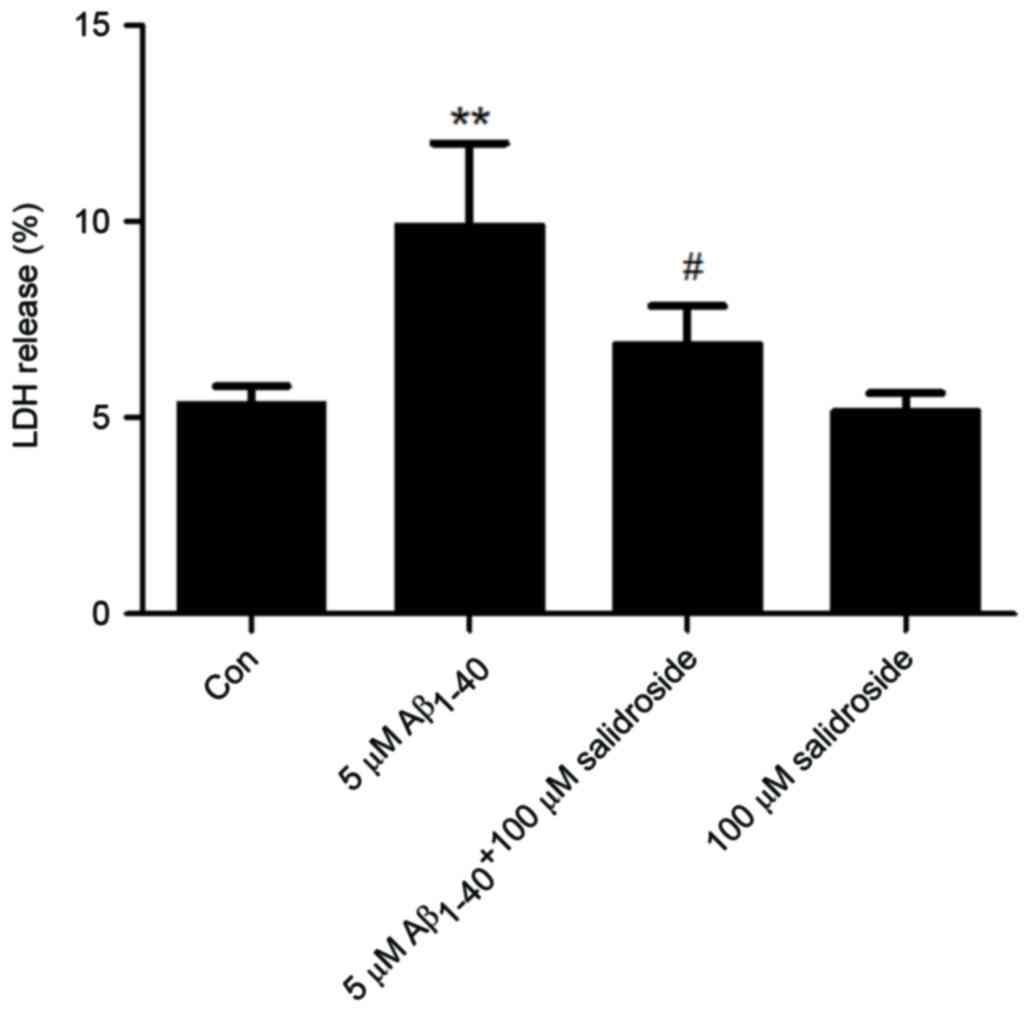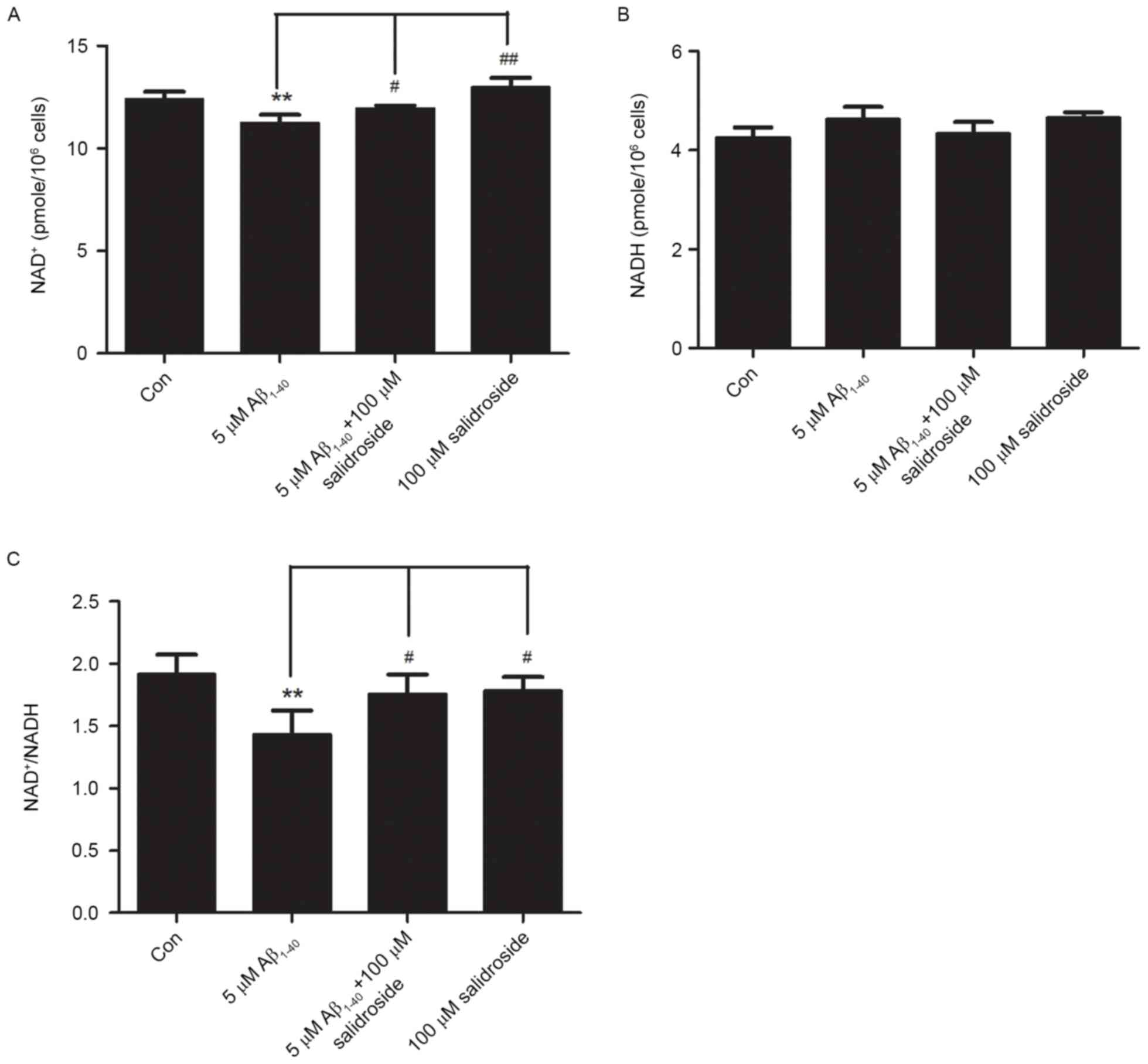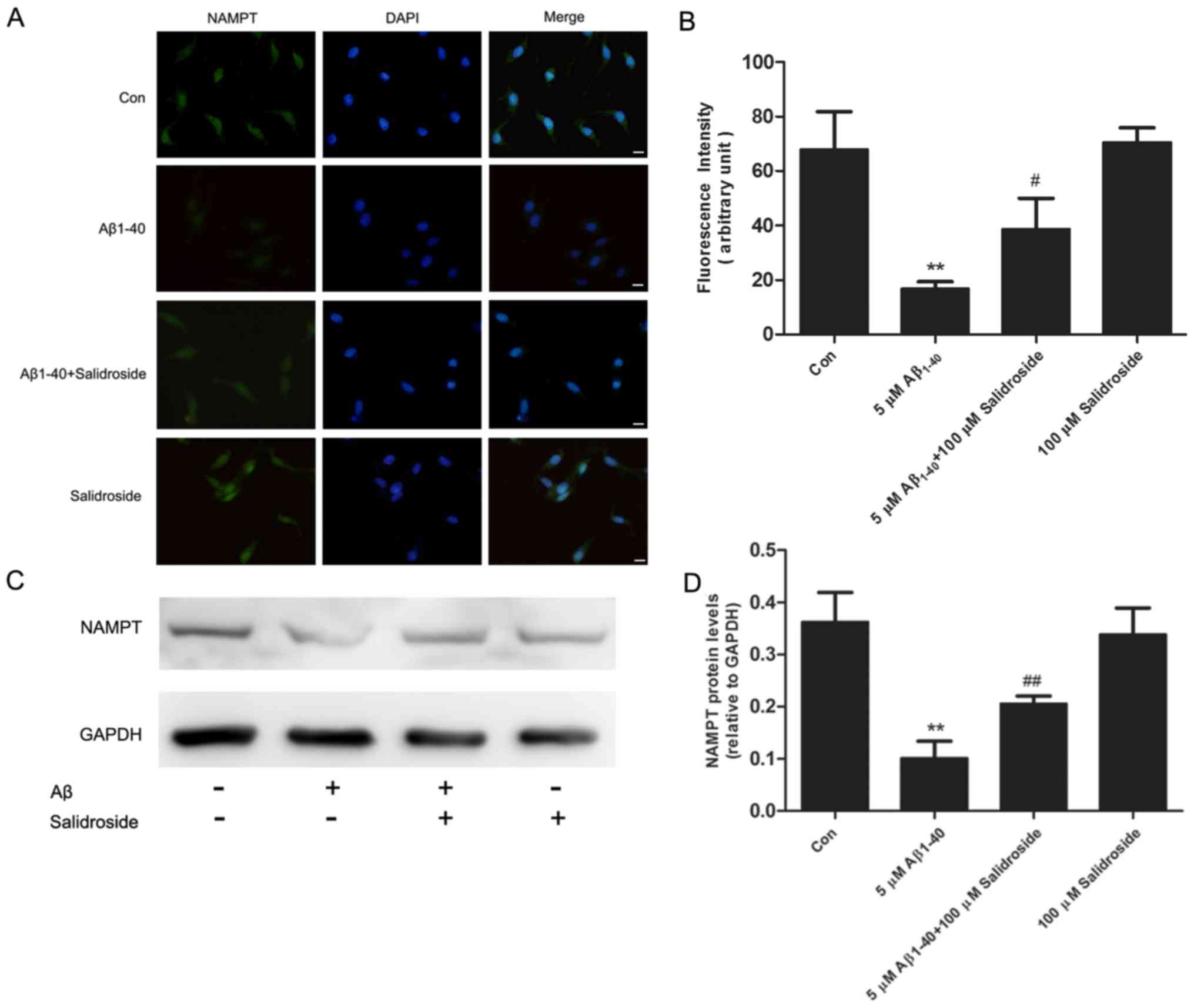|
1
|
Van Cauwenberghe C, Van Broeckhoven C and
Sleegers K: The genetic landscape of Alzheimer disease: Clinical
implications and perspectives. Genet Med. 18:421–430. 2016.
View Article : Google Scholar : PubMed/NCBI
|
|
2
|
Scheltens P, Blennow K, Breteler MM, de
Strooper B, Frisoni GB, Salloway S and Van der Flier WM:
Alzheimer's disease. Lancet. 388:505–517. 2016. View Article : Google Scholar : PubMed/NCBI
|
|
3
|
Perl DP: Neuropathology of Alzheimer's
disease. Mt Sinai J Med. 77:32–42. 2010. View Article : Google Scholar : PubMed/NCBI
|
|
4
|
Serrano-Pozo A, Frosch MP, Masliah E and
Hyman BT: Neuropathological alterations in Alzheimer disease. Cold
Spring Harb Perspect Med. 1:a0061892011. View Article : Google Scholar : PubMed/NCBI
|
|
5
|
Sadigh-Eteghad S, Sabermarouf B, Majdi A,
Talebi M, Farhoudi M and Mahmoudi J: Amyloid-beta: A crucial factor
in Alzheimer's disease. Med Princ Pract. 24:1–10. 2015. View Article : Google Scholar : PubMed/NCBI
|
|
6
|
Yin F, Boveris A and Cadenas E:
Mitochondrial energy metabolism and redox signaling in brain aging
and neurodegeneration. Antioxid Redox Signal. 20:353–371. 2014.
View Article : Google Scholar : PubMed/NCBI
|
|
7
|
Wang R, Li JJ, Diao S, Kwak YD, Liu L, Zhi
L, Büeler H, Bhat NR, Williams RW, Park EA and Liao FF: Metabolic
stress modulates Alzheimer's β-secretase gene transcription via
SIRT1-PPARγ-PGC-1 in neurons. Cell Metab. 17:685–694. 2013.
View Article : Google Scholar : PubMed/NCBI
|
|
8
|
Wu MF, Yin JH, Hwang CS, Tang CM and Yang
DI: NAD attenuates oxidative DNA damages induced by amyloid
beta-peptide in primary rat cortical neurons. Free Radic Res.
48:794–805. 2014. View Article : Google Scholar : PubMed/NCBI
|
|
9
|
Ussher JR, Jaswal JS and Lopaschuk GD:
Pyridine nucleotide regulation of cardiac intermediary metabolism.
Circ Res. 111:628–641. 2012. View Article : Google Scholar : PubMed/NCBI
|
|
10
|
Rongvaux A, Shea RJ, Mulks MH, Gigot D,
Urbain J, Leo O and Andris F: Pre-B-cell colony-enhancing factor,
whose expression is up-regulated in activated lymphocytes, is a
nicotinamide phosphoribosyltransferase, a cytosolic enzyme involved
in NAD biosynthesis. Eur J Immunol. 32:3225–3234. 2002. View Article : Google Scholar : PubMed/NCBI
|
|
11
|
Ying W: NAD+/NADH and
NADP+/NADPH in cellular functions and cell death:
Regulation and biological consequences. Antioxid Redox Signal.
10:179–206. 2008. View Article : Google Scholar : PubMed/NCBI
|
|
12
|
Revollo JR, Grimm AA and Imai S: The
regulation of nicotinamide adenine dinucleotide biosynthesis by
Nampt/PBEF/visfatin in mammals. Curr Opin Gastroenterol.
23:164–170. 2007. View Article : Google Scholar : PubMed/NCBI
|
|
13
|
Villela D, Schlesinger D, Suemoto CK,
Grinberg LT and Rosenberg C: A microdeletion in Alzheimer's disease
disrupts NAMPT gene. J Genet. 93:535–537. 2014. View Article : Google Scholar : PubMed/NCBI
|
|
14
|
Imai S and Guarente L: NAD+ and
sirtuins in aging and disease. Trends Cell Biol. 24:464–471. 2014.
View Article : Google Scholar : PubMed/NCBI
|
|
15
|
Herrera-Arozamena C, Martí-Marí O, Estrada
M, de la Fuente Revenga M and Rodríguez-Franco MI: Recent advances
in neurogenic small molecules as innovative treatments for
neurodegenerative diseases. Molecules. 21:pii: E1165. 2016.
View Article : Google Scholar : PubMed/NCBI
|
|
16
|
Qi Z, Qi S, Ling L, Lv J and Feng Z:
Salidroside attenuates inflammatory response via suppressing
JAK2-STAT3 pathway activation and preventing STAT3 transfer into
nucleus. Int Immunopharmacol. 35:265–271. 2016. View Article : Google Scholar : PubMed/NCBI
|
|
17
|
Yang ZR, Wang HF, Zuo TC, Guan LL and Dai
N: Salidroside alleviates oxidative stress in the liver with non-
alcoholic steatohepatitis in rats. BMC Pharmacol Toxicol.
17:162016. View Article : Google Scholar : PubMed/NCBI
|
|
18
|
Sun KX, Xia HW and Xia RL: Anticancer
effect of salidroside on colon cancer through inhibiting JAK2/STAT3
signaling pathway. Int J Clin Exp Pathol. 8:615–621.
2015.PubMed/NCBI
|
|
19
|
Zhang B, Wang Y, Li H, Xiong R, Zhao Z,
Chu X, Li Q, Sun S and Chen S: Neuroprotective effects of
salidroside through PI3K/Akt pathway activation in Alzheimer's
disease models. Drug Des Devel Ther. 10:1335–1343. 2016.PubMed/NCBI
|
|
20
|
Gao J, Zhou R, You X, Luo F, He H, Chang
X, Zhu L, Ding X and Yan T: Salidroside suppresses inflammation in
a D-galactose-induced rat model of Alzheimer's disease via
SIRT1/NF-κB pathway. Metab Brain Dis. 31:771–778. 2016. View Article : Google Scholar : PubMed/NCBI
|
|
21
|
Zhang W, Peng M, Yang Y, Xiao Z, Song B
and Lin Z: Protective effects of salidroside on mitochondrial
functions against exertional heat stroke-induced organ damage in
the rat. Evid Based Complement Alternat Med. 2015:5045672015.
View Article : Google Scholar : PubMed/NCBI
|
|
22
|
Yang Y and Sauve AA: NAD+
metabolism: Bioenergetics, signaling and manipulation for therapy.
Biochim Biophys Acta. 1864:1787–1800. 2016. View Article : Google Scholar : PubMed/NCBI
|
|
23
|
Selkoe DJ and Schenk D: Alzheimer's
disease: Molecular understanding predicts amyloid-based
therapeutics. Annu Rev Pharmacol Toxicol. 43:545–584. 2003.
View Article : Google Scholar : PubMed/NCBI
|
|
24
|
Cheng YF, Wang C, Lin HB, Li YF, Huang Y,
Xu JP and Zhang HT: Inhibition of phosphodiesterase-4 reverses
memory deficits produced by Aβ25–35 or Aβ1–40
peptide in rats. Psychopharmacology (Berl). 212:181–191. 2010.
View Article : Google Scholar : PubMed/NCBI
|
|
25
|
Miguel-Hidalgo JJ and Cacabelos R:
Beta-amyloid(1–40)-induced neurodegeneration in the rat hippocampal
neurons of the CA1 subfield. Acta Neuropathol. 95:455–465. 1998.
View Article : Google Scholar : PubMed/NCBI
|
|
26
|
Yue T, Shanbin G, Ling M, Yuan W, Ying X
and Ping Z: Sevoflurane aggregates cognitive dysfunction and
hippocampal oxidative stress induced by β-amyloid in rats. Life
Sci. 143:194–201. 2015. View Article : Google Scholar : PubMed/NCBI
|
|
27
|
He F, Cao YP, Che FY, Yang LH, Xiao SH and
Liu J: Inhibitory effects of edaravone in β-amyloid-induced
neurotoxicity in rats. Biomed Res Int. 2014:3703682014. View Article : Google Scholar : PubMed/NCBI
|
|
28
|
Carrillo-Mora P, Luna R and Colín-Barenque
L: Amyloid beta: Multiple mechanisms of toxicity and only some
protective effects? Oxid Med Cell Longev. 2014:7953752014.
View Article : Google Scholar : PubMed/NCBI
|
|
29
|
Han XH, Cheng MN, Chen L, Fang H, Wang LJ,
Li XT and Qu ZQ: 7,8-Dihydroxyflavone protects PC12 cells against
6-hydroxydopamine-induced cell death through modulating PI3K/Akt
and JNK pathways. Neurosci Lett. 581:85–88. 2014. View Article : Google Scholar : PubMed/NCBI
|
|
30
|
Guo M, Li D, Shen H, Jin B, Ren Y, Li M
and Xing Y: Leptin-Sensitive JAK2 activation in the regulation of
Tau phosphorylation in PC12 cells. Neurosignals. 24:88–94. 2016.
View Article : Google Scholar : PubMed/NCBI
|
|
31
|
Chen CL, Tsai WH, Chen CJ and Pan TM:
Centella asiatica extract protects against amyloid
β1-40-induced neurotoxicity in neuronal cells by activating the
antioxidative defence system. J Tradit Complement Med. 6:362–369.
2015. View Article : Google Scholar : PubMed/NCBI
|
|
32
|
Qian MC, Liu J, Yao JS, Wang WM, Yang JH,
Wei LL, Shen YD and Chen W: Caspase-8 mediates amyloid-β-induced
apoptosis in differentiated PC12 cells. J Mol Neurosci. 56:491–499.
2015. View Article : Google Scholar : PubMed/NCBI
|
|
33
|
Jieyu H, Chao T, Mengjun L, Shalong W,
Xiaomei G, Jianfeng L and Zhihong L: Nampt/Visfatin/PBEF: A
functionally multi-faceted protein with a pivotal role in malignant
tumors. Curr Pharm Des. 18:6123–6132. 2012. View Article : Google Scholar : PubMed/NCBI
|
|
34
|
Ghosh D, Levault KR and Brewer GJ:
Relative importance of redox buffers GSH and NAD(P)H in age-related
neurodegeneration and Alzheimer disease-like mouse neurons. Aging
Cell. 13:631–640. 2014. View Article : Google Scholar : PubMed/NCBI
|
|
35
|
Stein LR, Wozniak DF, Dearborn JT, Kubota
S, Apte RS, Izumi Y, Zorumski CF and Imai S: Expression of Nampt in
hippocampal and cortical excitatory neurons is critical for
cognitive function. J Neurosci. 34:5800–5815. 2014. View Article : Google Scholar : PubMed/NCBI
|
|
36
|
Cabezas-Opazo FA, Vergara-Pulgar K, Pérez
MJ, Jara C, Osorio-Fuentealba C and Quintanilla RA: Mitochondrial
dysfunction contributes to the pathogenesis of Alzheimer's disease.
Oxid Med Cell Longev. 2015:5096542015. View Article : Google Scholar : PubMed/NCBI
|
|
37
|
Zhu XH, Lu M, Lee BY, Ugurbil K and Chen
W: In vivo NAD assay reveals the intracellular NAD contents and
redox state in healthy human brain and their age dependences. Proc
Natl Acad Sci USA. 112:2876–2881. 2015. View Article : Google Scholar : PubMed/NCBI
|
|
38
|
Wang Y: Molecular links between caloric
restriction and Sir2/SIRT1 activation. Diabetes Metab J.
38:321–329. 2014. View Article : Google Scholar : PubMed/NCBI
|
|
39
|
Rodgers JT, Lerin C, Gerhart-Hines Z and
Puigserver P: Metabolic adaptations through the PGC-1 alpha and
SIRT1 pathways. FEBS Lett. 582:46–53. 2008. View Article : Google Scholar : PubMed/NCBI
|
|
40
|
Katsouri L, Parr C, Bogdanovic N, Willem M
and Sastre M: PPARγ co-activator-1α (PGC-1α) reduces amyloid-β
generation through a PPARγ-dependent mechanism. J Alzheimers Dis.
25:151–162. 2011.PubMed/NCBI
|
|
41
|
Yoshino J, Mills KF, Yoon MJ and Imai S:
Nicotinamide mononucleotide, a key NAD(+) intermediate, treats the
pathophysiology of diet- and age-induced diabetes in mice. Cell
Metab. 14:528–536. 2011. View Article : Google Scholar : PubMed/NCBI
|
|
42
|
Ghosh D, LeVault KR, Barnett AJ and Brewer
GJ: A reversible early oxidized redox state that precedes
macromolecular ROS damage in aging nontransgenic and 3xTg-AD mouse
neurons. J Neurosci. 32:5821–5832. 2012. View Article : Google Scholar : PubMed/NCBI
|


















